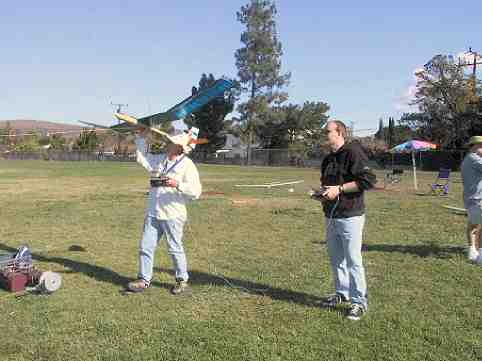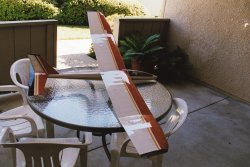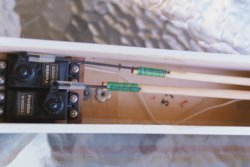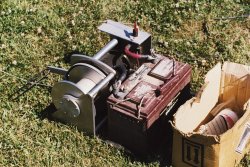Beginners
.......................................................................................................................................
Building and flying model sailplanes is a great sport that offers many rewards and challenges. When starting out there are many questions to be answered in order to ensure a reasonable amount of success. If you follow this basic outline you will minimize your frustration and most likely become a successful sailplane pilot. (This outline is not meant to provide you with every detail but a basic method for going about your search.) Many of your questions will be answered from discussions with other members, therefore visiting the flying site and asking questions is essential.
What to do first?
It is suggested that before you buy anything you visit the flying field and talk with the other members. If you ask, the club members can arrange for you to fly a club plane under the supervision of an instructor. This will give you hands-on experience and will offer you the opportunity to fly before you buy. You will want to do as much initial research as possible before buying any equipment or planes. Doing this step will minimize your costs by reducing the number of items that you must buy when you realized that you did not get the right item the first time. If you plan on flying the club plane (or your own) you will need to enroll with the Academy of Model Aeronautics (AMA) for insurance reasons. You can get free initial coverage for thirty days under the club's charter by filing out a form. After thirty days the costs for those under 18 years of age is just $1 per year while adults are $52 per year which includes a subscription to Model Aviation magazine. Generally, the sport is considered very safe but having the insurance protects you, the club, and the landowners. Claims are rare, which is why the insurance is so cheap, but they could be very expensive.
What is the cost?
Costs very greatly based on the type of plane and equipment you buy but a beginner's plane costs about $60 as a kit (cost includes the materials to assemble the plane) or about double that as a read assembled "almost ready-to-fly" (ARF) model. A radio system costs $90..$130. Used equipment is available but you need to be aware that its the right type (e.g. radios for model cars use a different frequency band) and that components such a rechargeable batteries have a limited life. Often you can find serviceable equipment by asking club members.
Who should you ask for advice?
There are many sources that offer advice of what you should do and there are just as many opinions of how you should begin with this sport Experience says that you want to talk with the other club members for your advice since they are the most familiar with the equipment being used and the local flying conditions. One of the mistakes that newcomers make is completely relying on the advice given from the local hobby shop personnel. They walk into the hobby shop and say they are interested in flying sailplanes and then walk out with all the necessary equipment. This often results in disappointment because the person selling you the plane invariably doesn't fly sailplanes and even a brand-new ARF is invariably out of adjustment so it just doesn't fly "right".
What type of plane to buy?
The normal beginner plane is a two function (rudder and elevator) plane with a "bent wing" (i.e. a "polyhedral") that's typically 2 to 3 meters (78" to 120") wingspan. They're usually built from wood but sometimes from foam. This plane is inherently stable -- it effectively flies itself -- so the beginner can spend time learning to steer the plane around without having to worry about it falling out of the sky. A typical beginner plane is a "2meter Spirit" but other ARFs include the "Gentle Lady", "Olympic" and "Paragon".
Where to start flying?
The best place to start is to come to the flying field at Redwood on a Sunday and ask. A club member will help you check out the plane to make sure that its assembled and balanced correctly. If you are confident that the plane will fly and you want to start flying then the normal place to start flying is off a hill like Smith Hill flying over long grass or other vegetation that will catch the plane before it crashes and gets damaged. Even on a hill its helpful to have someone experienced with you; flying is a skill that has to be practised. Its helpful during the early stages to fly with an experienced pilot using a "buddy box" system where your radio transmitter is slaved off another unit that's used by the experience flier. Control can be rapidly switched back and forth so that if the plane starts to misbehave then it can be recovered before it crashes.
A simulator program is also very useful.
Hill flying has the advantage of consistent lift for extended periods. It has the disadvantage that wind near the hill may make landings difficult, also if the lift goes away then you may find your plane drops somewhere out of sight in the weeds. (Smith Hill is not very large but it can take an hour or more to find a lost plane.)
Thermal flying off a flat field using a winch or high-start to launch the plane will give you a short flight unless you find lift. The landing area is relatively restricted (usually with other people standing around on it) and with houses or other obstructions off the field that preclude safe off-field landings. Your first flights should be with someone who already knows how to fly.
Frequency control.
The radios that you will use will be using channels in the 72MHz band. You have to get into the habit of never running your transmitted unless you know that nobody else is using that channel. The traditional way of doing this is to collect a clip or peg with the channel number on it from a "frequency board". If you don't have the clip or can't find it then don't turn on the transmitter. If someone else has the clip then you have to coordinate flights with them.
Always check that the radio system is working and that the control surfaces are moving freely and in the expected directions before launching you plane. (Its really difficult to fly a plane with the receiver switched off or one or more surfaces reversed.)
Launching equipment.
Planes are launched at the field using either a high-start or a winch The high starts are typically used with the smaller trainer planes since it offers simplicity. The high-start is simply surgical rubber tubing attached to line and staked to the ground at one end. The line is stretched and attached to the plane were it is then towed up to several hundred feet in the same manner as a kite. The winch can be used with all planes but requires some experience since it has the capability of pulling your plane very fast and hard (i.e. apart -- you can break planes on a winch). The winch is usually a car starter motor with a drum attached to the shaft. Braided fishing line is wound on the drum, the line going down the field, through a pulley (called a turnaround) and then brought back to the starting point where its attached to the plane. The winch is operated by a foot pedal that energizes the motor.
Winch lines can be dangerous. Be careful around them if you're visiting the field.
Finding Lift.
The key to successful sailplane flying is not to lose height by turning too frequently or too sharply -- just let the plane glide around. When the plane comes across lift then the rising air will push on the side of the wing that first comes across it so the plane will appear to turn for no reason at all. You will see it bank and turn and the lift will be to the side away from the turn (that is, the plane will turn away from the lift). You have to turn the plane around, usually by making a 270 degree turn, and head into the lift. Once the plane is rising then you circle inside the lift to gain height. Note that its polite to circle in the same direction as everyone else. (Thermals attract gaggles of planes.....and birds.)
Landing.
This is not as difficult as it sounds. Most beginner planes will more or less land themselves. Your task is to keep it pointed in the right direction -- usually into the wind -- and to resist the temptation to turn it steeply while it is flying slowly (this causes the inner wing to stop flying so the plane abruptly drops -- if this happens near the ground you're likely to hit the ground and knock the wing tip off). The usual beginners problems are coming in too fast or two slow, so leave plenty of space, let the plane land and walk over to pick it up. (As you get more practiced you can land it at your feet or even catch it.)
Conclusion.
This is just a basic outline to give you some initial advice on how to go about flying, its not an exhaustive guide to flying. Don't be afraid to ask around the club. There are also many useful sources on the Internet. Sailplane flying is a social activity, even competitive flying is friendly, so you should have no problem finding answers to your questions. Good Luck!

THOUSAND OAKS SOARING SOCIETY

Launching the club training plane, a Paragon. Note the linked transmitters.

A typical first plane, a 2 meter "Spirit"

The servos used to move the control surfaces

A typical electric winch used for launching larger planes
